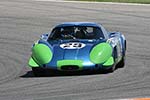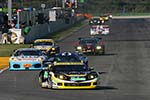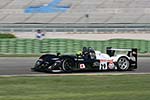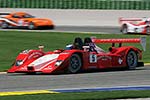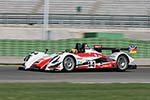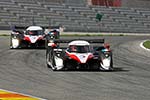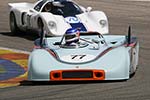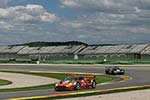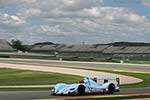
| Click here to save all images | Le Mans Series Valencia 1000 km |
| | 2007 | |
Not even three weeks after the flag fell at Monza, the Le Mans Series sprung back in action for the second round of the season. The Circuit Ricardo Tormo just west of Valencia was the courteous host of 2007�s second 1000 km race. The Spanish track�s biggest selling point is that it is built in a �stadium�, giving the spectators a view over the entire track from almost every vantage point. To make this possible, the track has a very compact design; ideal for motorcycle racing, but not necessarily for sportscars. After the bad experiences at Donnington and Jarama last year, it was quite surprising that the narrow Valencia track was chosen for the Spanish round. Another problem with the track was that there would not be enough pit-boxes for all 49 season entries. Fortunately enough teams had withdrawn their entry before the race, so nobody had to be refused. Among the withdrawals was one of the LMP1 Courages, which needed some additional wind-tunnel time and the new Creation, which was still under construction. Making its highly anticipated debut was the Audi engined Swiss Spirit Lola, intended in part to show that the rules really did not favour diesel engines. It was joined on the LMP1 grid by the new Zytek, entered by the Arena Motorsport team.
Our photographic team was on hand to capture the entire event, resulting in a complete report and an exclusive 160-shot slideshow.
Practice sessions
 As usual the teams were given three hours to familiarize themselves with the track in three one hour practice sessions. It took only ten minutes before the first major incident occurred with the Chad Panoz coming to a premature halt engulfed in flames. There was no sign of accident damage, so it could very well have been a fuel leak of sorts. Fortunately the driver got out unharmed and the car was ready in time for the third session. After a brief red flag period to extinguish and remove the Esperante, the session continued. It was immediately obvious that overtaking would be very difficult on the tricky track with its constant twists and turns. Amazingly there were no other major incidents, but it did not look very promising for the race.
As usual the teams were given three hours to familiarize themselves with the track in three one hour practice sessions. It took only ten minutes before the first major incident occurred with the Chad Panoz coming to a premature halt engulfed in flames. There was no sign of accident damage, so it could very well have been a fuel leak of sorts. Fortunately the driver got out unharmed and the car was ready in time for the third session. After a brief red flag period to extinguish and remove the Esperante, the session continued. It was immediately obvious that overtaking would be very difficult on the tricky track with its constant twists and turns. Amazingly there were no other major incidents, but it did not look very promising for the race.At the head of the field there were no surprises with the two Peugeots topping the charts. As expected the competition was slightly closer with the tight track favouring the nimbler petrol engined machines. It looked set to become a tight race when the final practice session was over with the top ten cars split by less than a second. Our hopes were quickly dashed by Peugeot driver Nicolas Minassian, who explained that their qualifying pace was another two or three seconds faster. Among that one-second top ten there were three of the lighter LMP2 cars, which were obviously also in their element. The quickest of the lot was the Barazi-Epsilon Zytek, which continued to impress. The other two were the familiar black and blue Quiffel Lola and the red-white-blue RML MG Lola. Somewhat off-putting was the performance of the new LMP2 Dome, which was freshly assembled and only put in a few laps, very slowly. A busy racing track really is not the place to shake down and test a new machine.
In GT1 the tables were somewhat turned with the three Astons struggling to match the others� pace, due to a lack of grip. One of the Corvette Team members suggested that the mid-engined layout of the Saleen gave them the edge. As at Monza, the GT2 class was a genuine Porsche vs. Ferrari battle, with Spyker and Panoz clearly playing second or even third fiddle. This was particularly disappointing for the Dutch manufacturer, who tested at Valencia in the pre-season and believed the track�s layout would suit them. The fastest Ferrari and Porsche were split by a hair at the end of the three hours, in favour of the former.
Qualifying
Watching from the team�s pit-box, �Quick� Nic saw his prediction fulfilled by his team-mate and local Marc Gene, who lapped the 4.750 km track in 1:23.489. It was enough for pole, beating the other Peugeot by just over four tenths. The third and fourth placed machines were not quite as predictable; both Zyteks. Hayanari Shimoda in the new LMP1 Zytek was �just� 1.1 seconds behind Gene, but also a second faster than the next best car in its class. Michael Vergers clocked a stellar lap, placing the Gulf livered �P2� alongside its big brother on the grid. The third row was again divided by a P1 and a P2, with the fastest of the Pescarolos getting the better of the RML MG Lola. It was all Lola on the fourth row with Alex Yoong in the Judd engined B07/10 lapping the track 3 tenths faster than Marcel Fassler in the Audi powered one. It might still have been early to judge, but it after qualifying it looked like Zytek was doing a better job at trying to prove Audi�s point than Swiss Spirit. Already three seconds slower than the oil-burners, the Rollcentre Pescarolo was ninth and the top ten was rounded off by the Iberian / Team Quiffel Lola. Just as a side note, the T2M Dome was out for five laps, coming no closer than 24 seconds off the pace.
After the prototypes had the track to themselves for 20 minutes, it was up to the GT cars to have a go at it. Usually the GT1 class is separated by mere fractions, but Valencia clearly did not favour the front-engined cars, who all qualified within a second. Sadly this was one second slower than Soheil Ayari in the faster of the two Saleens. There was more of an upset in the GT2 class with the quickest Ferrari no higher than fourth, more than a second slower than the pole sitting Imsa Performance Porsche. Panoz and Spyker again struggled, coming no closer than 1.8 seconds. There were problems again for the Chad Panoz, which effectively ended the qualifying for most teams as it got stuck in the gravel with less than two minutes to go.
The 1000 km of Valencia
At exactly one-thirty in the very sunny afternoon, the pace car moved over and the lights turned from red to green. Despite the grim expectations, the complete 46 car field survived the first few corners. The only incident of note was Michael Vergers running wide in his LMP2 Zytek. He tumbled down the field and spent most of the next two hours climbing back to the top of the class leaderboard. At the head of the field, the Peugeots pulled away and hit the back-markers within in ten minutes. The only one able to keep within striking distance was Shimoda in the new Zytek. Behind him the fourth place was disputed between the Charouz and Swiss Spirit Lolas, the fastest Pescarolo and the LMP2 MG-Lola. A flat tire for the Lola-Audi and technical problems for the Pescarolo and MG prematurely ended this battle in favour of Alex Yoong in the Czech Judd-engined LMP1.
The GT1 class followed the unfamiliar pattern set in the previous sessions, with the Oreca Saleen easily running away from the other Saleen. Behind them all other cars seemed to suffer from technical gremlins and/or unplanned excursions into the kitty litter. Luc Alphand in his Corvette C6.R was unable to display his Rallye Dakar winning skills when he got stuck in the gravel. There was a lot more excitement in the smaller GT class where the leading pack was never far apart. From the get go it looked like the Porsches had the upper hand and the Imsa Performance 997 GT3 RSR eventually managed to ease away.
After a relatively boring opening session the drama gradually increased towards the end of the race. The first sign of things to come was a slowing third place Zytek, which saw its stellar debut end in the pit box. Stefan Johansen did go again, but it was in vain. Not much later the other Zytek was also pushed back in the garage with paddle-shift problems. It was eventually fixed, but the Gulf livered machine was out of contention for the class win. The LMP2 class lead then changed hands many times as one by one the cars needed additional attending by the mechanics. From the looks of it the starter motors or the dynamos on these cars form the weak spot. We were then treated to a fine piece of racing between the two Peugeots as the Marc Gene was determined to take victory in �his� race. It was not to be as a clutch failure saw the #7 Peugeot limp back to the pits. The car did not reemerge. We were told the problem had been there from the start and that Gene�s spirited drive might have worsened the situation.
As the race progressed the Rollcentre Pescarolo with Joao Barbosa at the wheel emerged as the biggest challenger for the Charouz Lola, piloted by Stefan Mucke. The latter used the foulest of tactics to prevent being overtaken. At one point he forced Barbosa in the grass near the end of the long straight. Fortunately the Portuguese was in better rallying shape than Alphand and managed to get the car back out of the grass. Mucke probably learned a thing or two in DTM racing and he pushed Barbosa around enough times for the Pescarolo�s suspension to break, leaving Barbosa to limp to the finish. Understandably, Rollcentre�s principal Martin Short was furious and expressed feeling ashamed about giving Mucke his first LMP drive. Surprisingly Mucke was not penalized and he finished second behind the surviving Peugeot and ahead of the Lola Audi. Little changed in GT1 and Oreca scored an easy victory; they now look set to challenge the Aston and Corvette Works teams at Le Mans.
There were more displays of poor driving in the closing stages that proofed decisive in the LMP2 and GT2 class. In one of the trickiest parts of the track, the Saulnier Racing Courage tried to overtake the GT2 leading IMSA Performance Porsche, but returned to the racing line too early. The two came together and the Porsche was sent into the wall. The Saulnier team were mildly penalized with a 30-second stop-go and lost their second place in the LMP2 class to the Bruichladdich Radical. They regained that position when the Chad Panoz careened into the Radical in the penultimate lap. The Radical did manage to reach the finish in third, but with substantial damage to the left front suspension. The class victory was for the Iberian Lola despite having been pulled from the gravel twice. In GT2 the last minute drama handed the first ever international win for the 997 GT3 RSR to Xavier Pompidou and Marc Lieb in the Felbermayer Proton example. They finished just ahead of two Ferraris.
The diesel advantage
Since last year�s Le Mans there has been a lot of talk about the LMP1 regulations, which many believe favour diesel engines. The only competitor to really speak his mind has been Henri Pescarolo and he did so after Le Mans and again more recently after Peugeot�s debut win at Monza. He believes that the gap in lap times is caused by the much more powerful diesel engines, which have twice the torque of the most potent petrol units. The ACO�s official aim is to have all cars compete on equal grounds regardless of fuel type or aspiration. Audi, Peugeot and the ACO have always argued that the real difference lies in the chassis, which they believe is more advanced than those of the �privateer� teams. After all, Audi was this dominant with a petrol engine as well. To prove similar performance could be achieved with a petrol engine, Audi have pulled the all-conquering R8 engine off the shelve for the Swiss Spirit Lola. With a third place finish, they had a promising debut, but at no time did the Audi engined Lola threaten the Peugeots, even on the twisty Valencia track.
So where do the Peugeots make the difference? From our observations and those of some of the LMP1 drivers, the real advantage comes during the initial acceleration out of corners. As LMP1 entrant Hugh Chamberlain explained; the Peugeot reaches terminal velocity of around 300 km/h long before the end of the straight. The speed is probably capped off at that point by the more aggressive wings that help the car go through corners quicker as well. This definitely suggests a real torque advantage for the diesel engines. It is hard to say whether the rules were written like they are to make a return to Le Mans for Audi and Peugeot more appealing, but it would also be unfair on the two manufacturers to drastically change the rules to fully equalize them. Chamberlain did admit he greatly looked forward to seeing Audi and Peugeot go head to head. A final note on the subject: Henri Pescarolo�s personal car is a diesel.
Conclusion
Despite the concerns shared throughout the paddock about the narrowness of the track there were relatively few incidents. There were several offs and the previously mentioned bumps towards the end of the race, but it could have been much worse. Whether these decisive incidents were caused by fatigue or lack of experience, they unnecessarily dashed the dreams for several teams. All in all it was an interesting weekend and a good final practice session for next month�s big one; the 24 Hours of Le Mans.
Related Articles
 |
|
|||||||||||||||||||
|
|
|||||||||||||||||||
|
|
|||||||||||||||||||
|
|
|||||||||||||||||||
|
|
|||||||||||||||||||
|
|
|||||||||||||||||||
Report by Wouter Melissen and images by Wouter Melissen and Pieter Melissen for Ultimatecarpage.com.
| All Cars - Contact us - Privacy Statement - Top | © 1998 - 2024 Ultimatecarpage.com |




